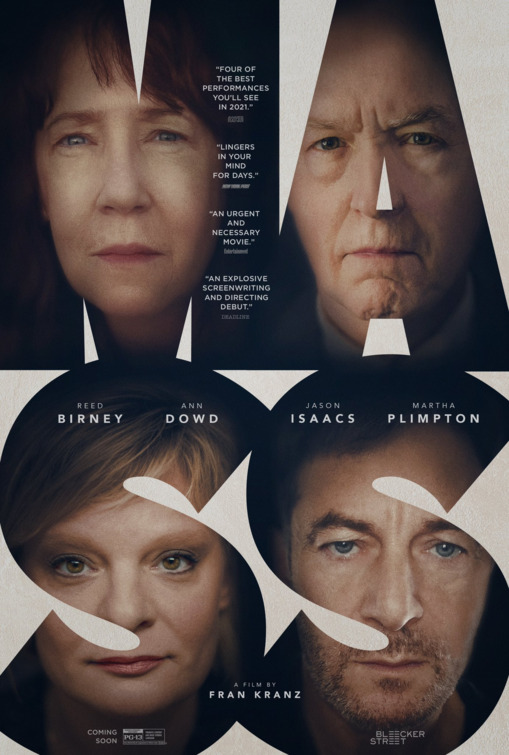Director
Fran Kranz
Starring
Jason Isaacs
Martha Plimpton
Ann Dowd
Reed Birney
Two sets of parents meet in the neutral ground of a church hall to discuss the aftermath of a school shooting that claimed the lives of their respective sons. Jay [Isaacs] and Gail [Plimpton] want some sort of reason or answer to justify what happened while Richard [Birney] and Linda [Dowd] try to detail the type of person their son was before he made the decision to commit the crime.
Mass is an outwardly straightforward pressure cooker chamber piece addressing the difficulty of needing to heal but having such great difficulty getting to the point where that is possible, as well as the struggle of not knowing exactly what anyone wants or how even to get there. Ultimately the story highlights the limitations of language, especially when clouded by grief, as the four main characters haphazardly blame society, institutions and themselves while trying to analyse post hoc why the events happened the way they did, knowing full well there will never be a satisfactory answer.
The first half an hour is uncomfortable viewing with the constant bubbling tension and fury at the back of the throat which is only broken at the end of the first quarter with Gail bluntly responding, “Why do I want to know about your son? Because he killed mine.” In truth, I’m surprised this wasn’t optioned to be a stage play rather than a film as it spools on in real time, giving the actors such a simple platform to express so much pain, sorrow and anger. And the performances on display here are truly masterful. The information slowly being unravelled and unveiled for the audience as the baton is passed between the four leads, each given their chance to take the foreground and reveal more and more details of the events; a method that could easily feel incredibly forced and clumsy in lesser hands.
Kranz’s direction is arguably so simple but it’s more the editing I think that really stands out, it elevates the performances and tension throughout and what little score there is feels like a horror movie with its dark ambient humming. Pacing-wise, the events draw to a natural point of close every 15 minutes or so and just when everything settles, it flares up again. In this way we get spikes but overall there is a clear bellcurve of emotion, from simple awkward opening pleasantries to at each others throats desperate for answers before finally returning to the same simple pleasantries; like a warm up and cool down.
This is clearly indicated (some could say heavy-handedly) from the quiet unassuming opening with very locked-off symmetrical shots carried by the captivating mundanity of the performances imbuing an ominous foreboding of what’s to come through the preparation of the spaces – even down to a child’s attempt at a stained glass heart shape made of crepe paper evoking negative feelings. This establishes a general sense of absence and emptiness so by the hour mark, the camera comes off the tripod and embodies the emotional escalation in the room as the shots become unstable. But as with before, just when you think the film is over and left wondering what is left to tell, Linda reappears with one final story and it’s crushing.
Creating a one-location narrative in real time with two seemingly opposed pairs going through the stages of grief – quite literally – should be cliche. It should be rote and amateur but through the way the film is presented and performed, it’s a spectacularly emotional experience. But there are those who will see cliche in the symbolism, it’s just a question of preference and tolerance. Case in point, transitioning from two couples separated by a table to four chairs in a circle, sitting in silence is the kind of writing that some may find obvious while others will feel is remarkably powerful.
Release Date:
11 October 2021
The Scene To Look Out For:
A subtle interesting choice, in addition to transitioning the way the film was shot from tripod to handheld as the tension escalates, was the decision to change the aspect ratio and lenses with a shallower depth of field to make the simple room even more claustrophobic, bringing you in.
Notable Characters:
It’s extremely hard to separate any of the performances but Martha Plimpton’s transition from being prickly and furious to arguably the most cathartically forgiving in the room is glorious. With Gail saying she made a promise to her deceased son that his death wouldn’t be in vain, that things would change when the country they live in seemingly never will and trying to focus on something innocent to highlight the value of a life cut short.
Highlighted Quote:
“It’s not whether it’s one thing or the other, that’s the fallacy, that’s their whole distraction defence. You know, don’t look over here by guns, look over there by mental health. You know, it’s not possible to address both, it’s insulting”
In A Few Words:
“A beautiful, harrowing, utterly understated, true American drama”
Total Score: 5/5

![The Red Right Hand Movie Reviews [Matthew Stogdon]](https://reviews.theredrighthand.co.uk/wp-content/uploads/2021/12/cropped-header1.png)



